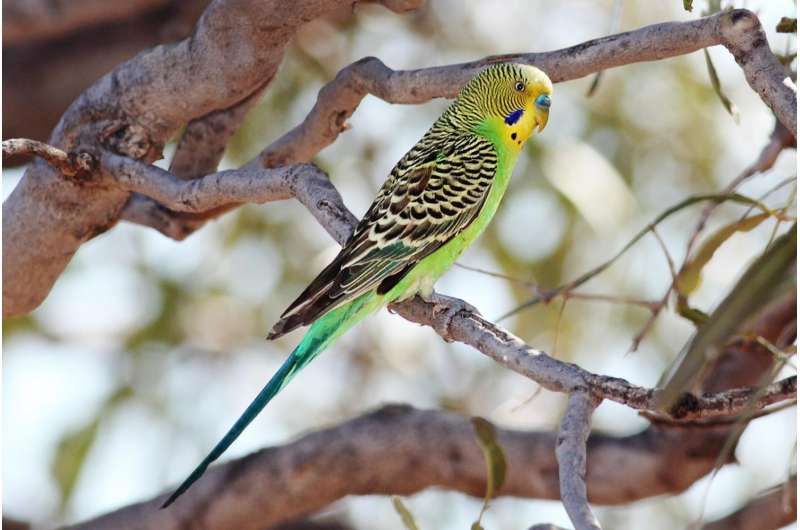June 22, 2016 report
Budgies found to fly at just two speeds

(Phys.org)—A pair of researchers has found that at least one type of birds flies at just two speed levels. In their paper published in the journal Biology Letters, Ingo Schiffner and Mandyam Srinivasan with the University of Queensland in Australia, describe tunnel tests they conducted with budgerigars, what they found and offer some theories on why the birds fly at just two speeds.
People have been enviously watching birds fly around for hundreds of thousands of years, but until now, no one has apparently noticed that they fly at only two speeds: fast and slow. This discovery came about as the two researchers were conducting experiments with budgies to learn more about how they respond to changes in their surroundings as they fly. They set several flying individually through a tapered tunnel, noting how they behaved, while also recording their flight speed. In checking the data, they found that all of the birds flew at just two speeds. They flew in fast mode when there were no obstructions and when going longer distances, then reverted to slow mode at a certain point in the tunnel when they gauged it narrow enough to do so. They noted that their slow mode was approximately half the speed of fast mode. They also noted that the faster mode of flight was the most efficient for the birds.
In looking even more closely at the data, the researchers found that the birds did not taper their flight speed, instead, the transitioned almost immediately from fast to slow and vice-versa, which is in stark contrast to insects—they speed up and slow down progressively. The researchers suggest the two speed modes for the birds offer some advantages, one of which is that is that it likely makes it easier for the birds to calculate distance, which is done by optic flow. Also, slow mode very clearly helps them avoid running into things.
The research by the team was conducted on just one species (10 budgies conducting 80 flights in total), thus it is still not clear if all bird species fly at just two speeds. Prior research has suggested there might be some exceptions, such as some species that fly at an accelerated speed during part of their long migrations.
More information: Budgerigar flight in a varying environment: flight at distinct speeds? Published 21 June 2016.DOI: 10.1098/rsbl.2016.0221 , rsbl.royalsocietypublishing.or … ontent/12/6/20160221
Abstract
How do flying birds respond to changing environments? The behaviour of budgerigars, Melopsittacus undulatus, was filmed as they flew through a tapered tunnel. Unlike flying insects—which vary their speed progressively and continuously by holding constant the optic flow induced by the walls—the birds showed a tendency to fly at only two distinct, fixed speeds. They switched between a high speed in the wider section of the tunnel, and a low speed in the narrower section. The transition between the two speeds was abrupt, and anticipatory. The high speed was close to the energy-efficient, outdoor cruising speed for these birds, while the low speed was approximately half this value. This is the first observation of the existence of two distinct, preferred flight speeds in birds. A dual-speed flight strategy may be beneficial for birds that fly in varying environments, with the high speed set at an energy-efficient value for flight through open spaces, and the low speed suited to safe manoeuvring in a cluttered environment. The constancy of flight speed within each regime enables the distances of obstacles and landmarks to be directly calibrated in terms of optic flow, thus facilitating simple and efficient guidance of flight through changing environments.
Journal information: Biology Letters
© 2016 Phys.org

















